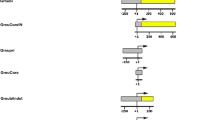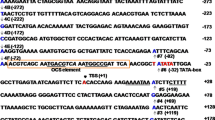Abstract
The characteristics of the soybean leghemoglobinlba gene promoter were analyzed and important promoter elements from thelba andlbc3 promoters were compared using transgenicLotus corniculatus plants. A 5′ deletion analysis of thelba promoter delimited twocis-acting elements controlling expression: a distal positive element (−1254, −884) required for expression and a proximal element (−285, −60) essential for full-level activity. In contrast to the corresponding region of thelbc3 promoter, thelba proximal element is unable to control expression from the heterologous CaMV 35S enhancer. The upstream positive element of thelba gene contains a position- and orientation-independent enhancer between positions (−1091, −788). The sequence of this enhancer region is conserved in thelbc3 gene upstream (−1333, −1132) of the previously assigned strong positive element (SPE; −1090, −947). The present analysis revealed some of the properties of this extendedlbc3 SPE element. The extended element (−1364, −947) functions in both orientations from 5′ locations whereas the SPE2 subcomponent (−1364, −1154) containing the conserved sequence is only active in the correct orientation. Removal of the SPE2 by internal deletion demonstrates that the SPE2 subcomponent is indispensable for the activity of thelbc3 upstream positive element. These results indicate that the upstream positive elements of thelba andlbc3 genes possess different properties although their conserved minimal enhancer sequence has similar function. This may reflect the differential expression of the twolb genes ofGlycine max L.
Similar content being viewed by others
References
de Bruijn FJ, Felix G, Grunenberg B, Hoffmann HJ, Mets B, Ratet P, Simons-Schreier A, Szabados L, Welters P, Schell J: Regulation of plant genes specifically induced in nitrogen-fixing nodules: Roles ofcis-acting elements andtrans-acting factors in leghemoglobin gene expression. Plant Mol Biol 13: 319–325 (1989).
de Bruijn FJ, Szabados L, Schell J: Chimeric genes and transgenic plants are used to study the regulation of genes involved in symbiotic plant-microbe interactions (nodulin genes). Devel Genet 11: 182–196 (1990).
Forde BG, Day HM, Turton JF, Shen W-J, Cullimore C, Oliver JE: Two glutamine synthetase genes fromPhaseolus vugaris L. display contrasting developmental and spatial patterns of expression in transgenicLotus corniculatus plants. Plant Cell 1: 391–401 (1989).
Hansen J, Jøgensen J-E, Stougaard J, Marcker KA: Hairy roots-short-cut to transgenic root nodules. Plant Cell Rep 8: 12–15 (1988).
Hattori M, Sakaki Y: Dideoxy sequencing using denatured plasmid templates. Anal Biochem 152: 232–238 (1986).
Jefferson RA, Kavanagh TA, Bevan MW: GUS fusion: β-Glucuronidase as a sensitive and versatile gene fusion marker in higher plants. EMBO J 6: 3901–3907 (1987).
Jensen EØ, Marcker KA, de Bruijn FJ, Schell J: Interaction of a nodule-specifictrans-acting factor with distinct DNA elements in the soybean leghemoglobinlbc3 5′ up-stream region. EMBO J 7: 1265–1271 (1988).
Jørgensen J-E, Stougaard J, Marcker A, Marcker KA: Root nodule specific gene regulation: analysis of the soybean N23 gene promoter in heterologous symbiotic systems. Nucl Acids Res 16: 39–50 (1988).
Jørgensen J-E, Stougaard J, Marcker KA: A two-component nodule-specific enhancer in the soybean N23 gene promoter. Plant Cell 3: 819–827 (1991).
Kuhlemeier C, Strittmatter G, Ward K, Chua N-H: The pearbcS-3A promoter mediates light responsiveness but not organ specificity. Plant Cell 1: 471–478 (1989).
Lauridsen P, Franssen H, Stougaard J, Bissling T, Marcker KA: Conserved regulation of the soybean early nodulin ENOD2 (B) gene promoter in determinate and indeterminate transgenic root nodules. Plant J 3: 483–492 (1993).
Lauridsen P, Sandal NN, Kühle A, Marcker KA, Stougaard J: Regulation of nodule specific genes. In: Herrmann RG, Larkins B, (eds) Plant Molecular Biology vol. 2, pp. 131–137. Plenum Press. New York (1991).
Marcker A, Lund M, Jensen EØ, Marcker KA: Transcription of the soybean leghemoglobin genes during nodule development. EMBO J 3: 1691–1695 (1984).
Nap J-P, Bisseling T: Developmental biology of plant-procaryote symbiosis: the legume root nodules. Science 250: 948–954 (1990).
Petit A, Stougaard J, Marcker KA, Tempé J: Transformation and regeneration of the legumeLotus corniculatus: a system for molecular studies of symbiotic nitrogen fixation. Mol Gen Genet 207: 245–250 (1987).
Ramlov K, Laursen NB, Stougaard J, Marcker KA: Site-directed mutagenesis of the organ specific element in the soybeanlbc3 gene promoter. Plant J, in press.
Sambrook J, Fritsch EF, Maniatis T: Molecular Cloning: A Laboratory Manual, 2nd ed. Cold Spring Harbor Laboratory, Cold Spring Harbor, NY (1989).
Sandal NN, Bojsen K, Marcker KA: A small family of nodule specific genes from soybean. Nucl Acids Res 15: 1507–1519 (1988).
Scheres B, van Engelen F, van der Knaap E, van de Weil C, van Kammen A, Bisseling T: Sequential induction of nodulin gene expression in the developing pea nodule. Plant Cell 2: 687–700 (1990).
Scheres B, van de Weil C, Zalensky A, Horvath B, Spaink H, van Eck H, Gloudeman T, van Kammen A, Bisseling T: The ENOD12 gene product is involved in the infection process during the pea-Rhizobium interaction. Cell 60: 281–294 (1990).
She Q, Sandal NN, Stougaard J, Marcker KA: Comparative sequence analysis ofcis elements present inGlycine max L. leghemoglobinlba andlbc3 genes: Plant Mol Biol, in press.
Shen W-J, Williamson MS, Forde BG: Functional analysis of the promoter region of a nodule-enhanced glutamine synthetase gene fromPhaseolus vulgaris L. Plant Mol Biol 19: 837–846 (1992).
Spector T: Refinement of the Coomassie Blue method of protein quantitation. Anal Biochem 86: 142–146 (1978).
Stougaard J, Marcker KA, Otten L, Schell J: Nodule specific expression of a chimeric soybean leghemoglobin gene in transgenicLotus corniculatus. Nature 321: 669–674 (1986).
Stougaard J, Sandal NN, Grøn A, Kühle A, Marcker KA: 5′ Analysis of the soybean leghemoglobinlbc3 gene: regulatory elements required for promoter activity and organ specificity. EMBO J 6: 3565–3569 (1987).
Stougaard J, Jørgensen J-E, Christensen T, Kühle A, Marcker KA: Interdependence and nodule specificity ofcis-acting regulatory elements in the soybean leghemoglobinlbc3 and N23 gene promoters. Mol Gen Genet 220: 353–360 (1990).
Szabados L, Ratet P, Grunenberg B, de Bruijn FJ: Functional analysis ofSesbania rostrata leghemoglobin geneglb3 5′-upstream region in transgenicLotus corniculatus andNicotiana tabacum plants. Plant Cell 2: 973–986 (1990).
van de Wiel C, Norris JH, Bochenek B, Dickstein R, Bisseling T, Hirsch AM: Nodulin gene expression and ENOD2 localization in effective, nitrogen-fixing and in-effective, bacteria-free nodules of alfalfa. Plant Cell 2: 1009–1017 (1990).
van de Wiel C, Scheres B, Franssen H, van Lierop M-J, van Lammeren A, van Kammen A, Bisseling T: The early nodulin transcript ENOD2 is located in the root parenchyma (inner cortex) of the pea and soybean nodules. EMBO J 9: 1–7 (1990).
van Haaren MJJ, Houck CM: Strong negative and positive regulatory elements contributing to the high-level fruit-specific expression of the tomato 2A11 gene. Plant Mol Biol 17: 615–630 (1991).
Van Haute E, Joos H, Maes M, Warren G, van Montagu, Schell J: Intergenic transfer and exchange recombination of restriction fragments cloned into pBR322: A novel strategy for reversed genetics of the Ti-plasmids ofAgrobacterium tumefaciens. EMBO J 2: 411–417 (1983).
Author information
Authors and Affiliations
Rights and permissions
About this article
Cite this article
She, Q., Lauridsen, P., Stougaard, J. et al. Minimal enhancer elements of the leghemoglobinlba andlbc3 gene promoters fromGlycine max L. have different properties. Plant Mol Biol 22, 945–956 (1993). https://doi.org/10.1007/BF00028968
Received:
Accepted:
Issue Date:
DOI: https://doi.org/10.1007/BF00028968




